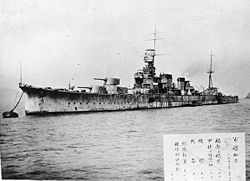Kako (ship, 1926)
|
Heavy cruiser Kako 1926
|
||||||||||||||||||
|
||||||||||||||||||
|
||||||||||||||||||
|
||||||||||||||||||
|
||||||||||||||||||
The Kako ( Japanese加 古) was the second ship of the Furutaka class , a group of two heavy cruisers of the Imperial Japanese Navy . The ship was named after the Kakogawa River in Hyogo Prefecture . It was built at the Kawasaki shipyard in Kobe .
Calls
At the beginning of the Pacific War in late 1941, the Kako was assigned to the 6th Cruiser Division and was involved in the occupation of Guam and the second attack on Wake Island on December 23, 1941. The Kako later supported operations in the Solomon Islands and New Guinea , including the capture of Rabaul , Salamaua and the Admiralty Islands . She was also involved in the Battle of the Coral Sea in May 1942.
Downfall
During the battle off Savo Island on August 9, 1942, the Kako damaged the American cruisers USS Astoria and USS Vincennes and helped sink the USS Quincy and the Australian cruiser HMAS Canberra . The Kako suffered no damage during the first day of the battle. However, the cruiser was sighted by the American submarine S-44 on the way back to Kavieng , New Ireland , a day later . Of four torpedoes fired, three hit the Kako in the area of the front turret, the front ammunition chamber and near the boiler room.
The Kako began to capsize, and only 35 minutes after the initial hit it was completely sunk. Your last position was 2 ° 28 ' S , 152 ° 11' O near the island Simbari . 34 crew members were killed, Taisa Takahashi and the rest of the crew were saved.
Evidence and references
Remarks
- ↑ for 1939 according to Japanese Cruisers of the Pacific War. P. 803 - Construction dates before modernization are described in the class article.
- ↑ The Japanese rank Taisa literally means great assistance and corresponds to the German rank of captain at sea .
literature
- Eric LaCroix, Linton Wells: Japanese Cruisers of the Pacific War. US Naval Institute Press, 1997, ISBN 0-87021-311-3 .
Web links
- Jon Parshall, Bob Hackett, Sander Kingsepp, Allyn Nevitt: Imperial Japanese Navy, Furutaka class (Combinedfleet.com) . Retrieved April 9, 2007.

